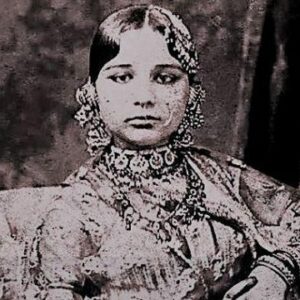As the “Begum of Awadh,” Begum Hazrat Mahal was one of the first women to fight for their freedom during the First Indian War of Independence. She was the first spouse of Nawab Wajid Ali Shah and showed leadership and courage by leading a revolt against the British East India Company in 1857. She assumed control of the state’s administration after the British conquered their area and Nawab Wajid Ali Shah, the King of Awadh, was forced into exile in Calcutta. She later took control of Lucknow alongside the revolutionary forces and proclaimed her son the new King of Awadh. She and other revolutionaries fought the British soldiers during the first fight for Indian independence, playing a crucial role in the conflict. But after a protracted siege, the British troops were able to retake Awadh, forcing her to flee. She refused to accept any favors or accommodations provided by the British monarchy. She eventually sought refuge in Nepal, where she later passed away. She was the sole significant leader who refused to submit to the British, and she continued to support her cause up until her death after living in exile in Nepal for 20 years.
Early Childhood & Life
She was born Muhammadi Khanum in 1820 in Faizabad, Awadh, India, from a disadvantaged Syed family who was descended from the Prophet Muhammad.
She was a courtesan by trade, and after her parents sold her, she was accepted as a “khawasin” into the royal harem. She afterward became a “pari” after being promoted and sold to Royal agents.
A Later Years
She was elevated and given the title of a begum after being approved as the King of Awadh’s mistress. After the birth of her son, Birjis Quadra, she was later given the title “Hazrat Mahal.” She was the younger spouse of Nawab Wajid Ali Shah, the previous Tajdaar-e-Awadh.
She wanted the Nawab to resist and defend the kingdom on the battlefield in 1856 when the British East India Company conquered the state of Awadh and demanded that he abdicate. However, her husband, the King of Awadh, abdicated and was exiled to Calcutta.
She then resolved to take matters into her own hands and work to reclaim Awadh from the British. She led the rural people to join the conflict while fighting valiantly. Later, once her armies had taken over Lucknow, she installed her 14-year-old son as king of Awadh on July 5, 1857.
She was able to retake Awadh’s lost area from British rule thanks to the help of the local populace. She became one of the major commanders in the conflict within a year, in 1857 when India’s first uprising for independence started and people rebelled against the British.
She bravely participated in the first Indian liberation battle alongside other well-known figures from 1857 including Nana Saheb, Beni Madho, Tatya Tope, Kunwar Singh, Firuz Shah, and all other northern Indian revolutionaries.
She had a special role in the 1857 conflict alongside Rani Laxmi Bai, Bakht Khan, and Maulvi Ahmadullah. She participated in the war in addition to being a strategist. She collaborated with Nana Saheb while working there and afterward took part in the assault on Shahjahanpur with the Maulavi of Faizabad.
Later, the British forces invaded her realm in an effort to retake the state of Awadh. On March 16, 1858, the British company was able to recapture Lucknow and the majority of Awadh despite her valiant attempts to rescue her state. She left Awadh once her forces started to lose ground and attempted to gather troops once more elsewhere.
Even though she maintained an army in the field for the entire following year after the defeat, she was never able to relocate herself and her son to Lucknow. She further claimed that the British were occupying the nation under the guise of native unrest and requested that her family be reinstated as the legitimate rulers.
She briefly resided in Terai, but by the end of 1859, she had lost the majority of her supporters and had to flee to Nepal, where she was eventually granted permission to stay. She used all of her money to support the 100,000 refugees who had come to Nepal with her in 1857.
Later, the British offered her a sizable pension if she would go back to her kingdom and work with them, but she declined. She was permitted to live in the Himalayan kingdom where she passed away in 1879 despite requests from the British authorities for her to be handed over so she might stand prosecution.
Personal Legacy & Life
At the age of 59, she passed away in Kathmandu, Nepal, on April 7, 1879. She was laid to rest in an unmarked cemetery on the grounds of the Jama Masjid in Kathmandu.
Estimated Net Worth
Unknown.


